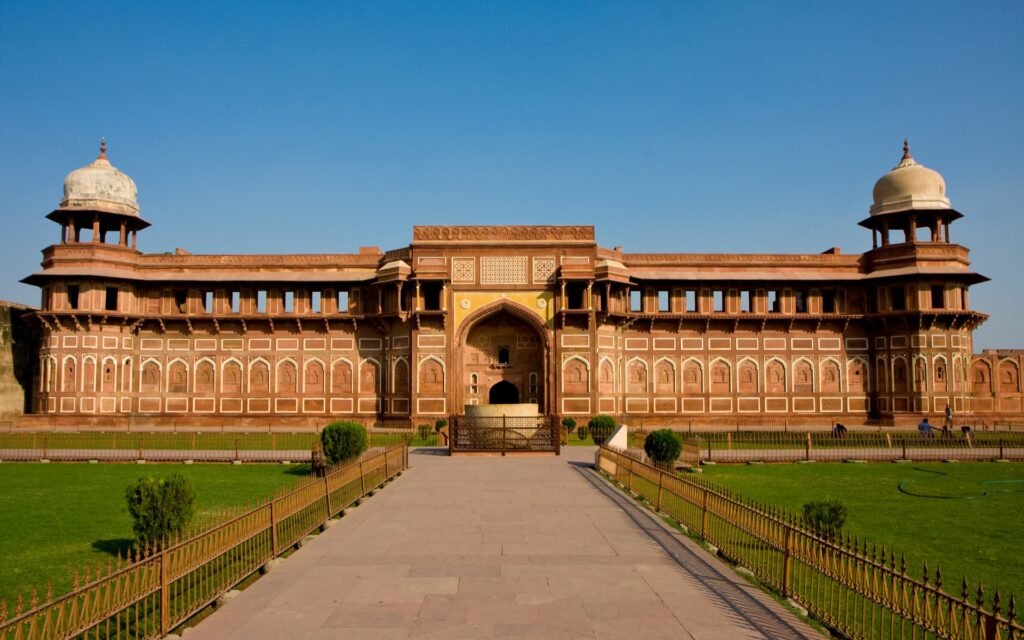Islamic Influence on India’s architecture
Islamic architecture has played a significant role in shaping India’s architectural landscape. It emerged when Muslim conquerors arrived in India in the 12th century.
The Mughal dynasty was the one to influence Islamic architecture in India. The Mughals brought a rich tradition of Islamic art and architecture. Islamic architecture in India influenced the construction of mosques, tombs, and other buildings.
Some of the most iconic structures in India, such as the Taj Mahal, the Jama Masjid and the Qutub Minar are examples of Islamic architecture.

Islamic Architecture
One of the most prominent features of Islamic architecture is the use of geometric patterns and designs. Calligraphy is an essential element of Islamic architecture with verses from the Quran often incorporated into the design.
Domes are often used to cover large interior spaces in mosques and tombs and arches are used to create an elegant and graceful transition between spaces. Materials such as wood, stone and bricks are used in Islamic architecture. Islamic architecture is renowned for its beauty and elegance.
Overall, Islamic architecture reflects the cultural and religious values of the Islamic world and continues to inspire architects and designers around the world.

Following are some of the Indian structures influenced by Islamic architecture.
Qutub Minar, New Delhi
Qutub Minar is located in Delhi, India, It is influenced by Islamic architecture, The Qutub Minar was built during the period of Muslim rule in India and it is considered one of the most significant examples of Indo-Islamic architecture.
The Qutub Minar is a towering minaret that stands over 70 meters tall. It is made of red sandstone and marble. The minaret was built in the 12th century by the Muslim ruler Qutub-ud-din Aibak and has since become a symbol of the Islamic influence on Indian architecture.
The minaret is adorned with beautiful calligraphy, including verses from the Quran, which are considered sacred in the Islamic faith.

Adhai Din Ka Jhopra, Ajmer
Adhai Din Ka Jhopra, located in Ajmer, Rajasthan, India, it was built by Muslim ruler Qutub-ud-Din Aibak in the 12th century. The mosque is considered to be an excellent example of Indo-Islamic architecture, with a mix of Hindu and Islamic architectural styles such as the use of Islamic arches and Hindu pillars.
The mosque is adorned with intricate calligraphy and carvings of Islamic geometric patterns which are characteristic features of Islamic architecture.
Therefore, it can be said that Adhai Din Ka Jhopra was significantly influenced by Islam and represents the fusion of Hindu and Islamic architectural styles and cultural influences.

Charminar, Hyderabad
Charminar was built during the reign of the Qutub Shahi dynasty, which was a Muslim dynasty that ruled the region of Hyderabad. The construction of the Charminar was inspired by Islamic architecture, specifically the style of Iranian architecture.
Charminar is a famous monument located in the city of Hyderabad, India. It was built in 1591 by the Qutub Shahi dynasty’s ruler, Muhammad Quli Qutb Shah, to commemorate the end of a deadly plague that had ravaged the city.
The Charminar is a massive structure made of granite and limestone, and it features four minarets that are each 56 meters tall. The structure is decorated with intricate carvings and has a mosque located on its top floor.

Gol Ghumraz, Karnataka
Gol Gumbaz is a mausoleum located in the city of Bijapur, Karnataka. It was built during the reign of the Adil Shahi dynasty, in 16th and 17th centuries.
The monument is known for its massive dome, which is one of the largest in the world and is supported by four massive corner towers. The structure also includes a mosque and a tomb, the intricate carvings and geometric patterns on the walls and ceilings of the mausoleum are also characteristic of Islamic art and design.
The dome of the monument produces a unique echo, which can be heard several times when a sound is made at a particular spot in the central chamber of the mausoleum.

Taj Mahal, Agra
The Taj Mahal is located in Agra, India, it was built by Mughal emperor Shah Jahan in memory of his beloved wife, Mumtaz Mahal. Many of the architectural features of the Taj Mahal are inspired by Islamic art and architecture.
The design of the Taj Mahal incorporates elements of Persian and Indian architecture as well. However, the overall style of the Taj Mahal is unique to the Mughal Empire and reflects the cultural synthesis that was characteristic of the era.

Agra Fort, Agra
Agra Fort is located in Agra, India. It was built during the reign of Mughal Emperor Akbar in the 16th century and was further expanded by his grandson Shah Jahan in the 17th century.
Agra Fort’s architecture and design were not solely inspired by Islam. Rather, it is a fusion of different architectural styles, including Islamic, Hindu, and Persian influences. Therefore, Agra Fort’s design, it is inaccurate to say that it was solely inspired by Islam.

Jama Masjid, Delhi
Jama Masjid is a mosque located in Old Delhi, India. It was built by the Mughal emperor Shah Jahan in the mid-17th century and is one of the largest mosques in India. As a religious monument, the Jama Masjid is certainly inspired by Islam, which is the religion of the Mughal Empire that commissioned its construction.
The architecture of the Jama Masjid incorporates many of the features that are typical of Islamic mosque design. The mosque has a large central courtyard that is surrounded by covered walkways, known as arcades, and a large prayer hall with a central prayer niche, or mihrab.
The design of the Jama Masjid also reflects the Mughal Empire’s unique style of architecture. The mosque’s red sandstone and white marble construction, calligraphy.

Jamali Kamali Mosque & Tomb, Delhi
Jamali Kamali is located in the Mehrauli Archaeological Park in Delhi, India. It consists of a mosque and tomb complex that dates back to the 16th century. The mosque and tomb complex were built during the reign of the Mughal emperor Akbar, who was known for his religious tolerance and his patronage of the arts.
The design of the Jamali Kamali complex reflects the Mughal Empire’s unique style of architecture. The mosque features a large central courtyard, surrounded by covered walkways with arches, and a prayer hall with a central prayer niche. The tomb of Jamali is adorned with intricate work and calligraphy, which are typical of Islamic art.
The complex’s intricate floral motifs, geometric patterns, and stucco ornamentation are characteristic of the Mughal style, which blended Islamic, Persian, and Indian decorative traditions.





